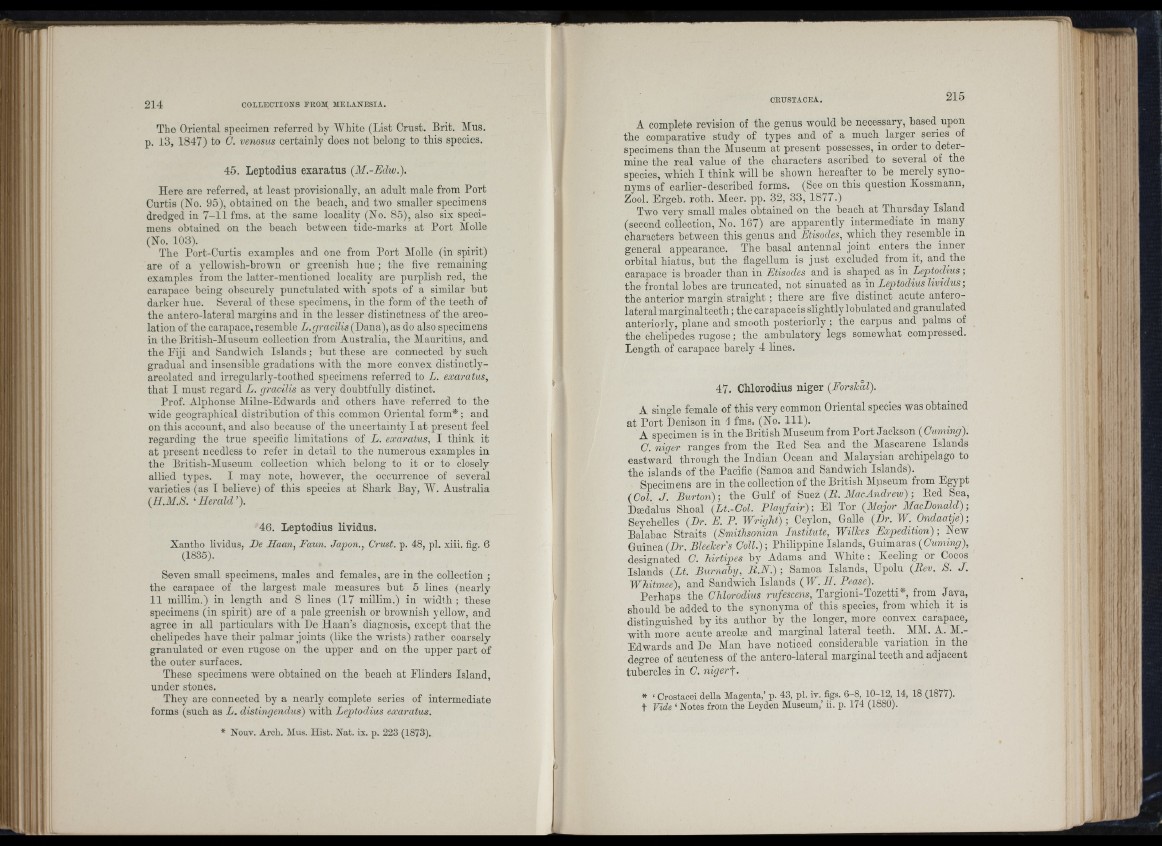
f î 'H 5 The Oriental specimen referred by White (List Crust. Brit. AIus.
p. i3 , 1847) to G. venosus certainly does not belong to this species.
11:?
nil
f : 'i
45. Leptodius exaratus (AI.-Edw.).
Here are referred, at least provisionaUy, an adult male from Port
Curtis (No. 95), obtained on the beach, and two smaller specimens
dredged in 7-11 fms. at the same locality (No. 85), also six specimens
obtained on the beach between tide-marks at Port Alolle
(No. 103).
The Port-Curtis examples and one from Port Alolle (in spirit)
are of a yellowish-brown or greenish h u e ; the five remaining
examples from the latter-mentioned locality are purplish red, the
carapace being obscurely punctulated with spots of a similar but
darker hue. Several of these specimens, in the form of the teeth of
the antero-lateral margins and in the lesser distinctness of the areo-
latiou of the carapace, resemble L. gracilis (J)ana), as do also specimens
in the British-Aluseum collection from Australia, the Alauritius, and
the Piji aud Sandwich Islan d s; hut these are connected by such
gradual aud insensible gradations with the more convex distiuctly-
areolated and irregularly-toothed specimens referred to L. exaratus,
th at I must regard L. gracilis as very doubtfully distinct.
Prof. Alphonse Alilne-Edwards and others have referred to the
wide geographical distribution of this common Oriental form*; and
on this account, aud also because of the uncertainty I at present feel
regarding the true specific limitations of L. exaratus, I think it
a t present needless to refer in detail to the numerous examples in
the British-Museum collection -which belong to it or to closely
allied types. I may note, however, the occurrence of several
varieties (as I believe) of this species at Shark Bay, AV. Australia
(H.Al.S. ‘ Herald j .
46. Leptodius lividus.
Xantho lividus, De Haan, Faun. Japon., Crust, p. 48, pi. xiii. fig. 6
(1835).
Seven small specimens, males and females, are in the collection ;
the carapace of the largest male measures hut 5 lines (nearly
11 millim.) in length and 8 lines (17 millim.) in width ; these
specimens (in spirit) are of a pale greenish or brownish yellow, and
agree in all particulars with De Haan’s diagnosis, except that the
chelipedes have their palmar joints (like the wrists) rather coarsely
granulated or even rugose on the upper and on the upper part of
the outer surfaces.
These specimens were ohtained on the beach at Elinders Island,
under stones.
They are connected by a nearly complete series of intermediate
forms (such as L. distingendus) with Leptodius exaratus.
J>
A complete revision of the genus would be necessary, based upon
the comparative study of types and of a much larger series of
specimens than the Museum at present possesses, in order to determine
the real value of the characters ascribed to several of the
species, which I think will be shown hereafter to be merely synonyms
of earlier-described forms. (See on this question Kossmann,
Zool. Ergeb. roth. Meer. pp. 32, 33, 1877.)
Two very small males ohtained on the beach at Thursday Island
(second collection, No. 167) are apparently intermediate in many
characters between this genus aud Etisodes, which they resemble in
general appearance. The basal antennal joint enters the inner
orbital hiatus, but the flagellum is ju s t excluded from it, and the
carapace is broader than in Etisodes and is shaped as in Leptodius;
the frontal lobes are truncated, not sinuated aa in Lep>todius lividus;
the anterior margin s tra ig h t; there are five distinct acute anterolateral
marginal te e th ; the carapace is slightly lobulated and granulated
anteriorly, plane and smooth posteriorly ; the carpus and palms of
the chelipedes rugose; the ambulatory legs somewhat compressed.
Length of carapace barely 4 lines.
n i l
■i !
47. Chlorodius niger (Forslccd).
A single female of this very common Oriental species was ohtained
at Port Denison in 4 fms. (No. H I ) .
A specimen is in the British Aluseum from Port Jackson (Gwminf/).
C. niger ranges from the Bed Sea and the Mascarene Islands
eastward through the Indian Ocean and Alalaysian archipelago to
the islands of the Pacific (Samoa and Sandwich Islands).
Specimens are in the collection of the British Aluseum from Egypt
(Col J Burton); the Gulf of 8,nez (B. Alac Andrew) ; Bed Sea,
Dædalns Shoal (Lt.-Col. Playfair); El Tor (Alajor AlacDonald);
Seychelles (Dr. E. P. Wright); Ceylon, Galle (Dr. W Ondaatje);
Balahac Straits (Smithsonian Institute, Wilkes Expedition); New
Guinea (Dr. Bleeker s Coll.) ; Philippine Islands, Guimaras (Cuming),
designated C. hirtipes by Adams and AVhite : Keeling or Cocos
Islands (Lt. Burnaby, B .N .); Samoa Islands, Upolu (Bev. S. J .
Whitmee), and Sandwich Islands (IE. II. Pease).
Perhaps the Chlorodius rufescens, Targioni-Tozetti*, from Java,
should he added to the synonyma of this species, from which it is
distinguished by its author by the longer, more convex carapace,
with more acute areolæ and marginal lateral teeth. _ MM. A. M.-
Edwards and De Alan have noticed considerable variation in the
degree of acuteness of the antero-lateral marginal teeth and adjacent
tubercles in 0. niger j .
* ‘ Crostacei della Alagenta,’ p. 43, pi. iv. figs. 6-8, 10-12, 14, 18 (18/7).
t Vide ‘ Notes from the Leyden Aluseum,’ ii. p. 174 (1880).
Î '
ii
i
... I
f I •»
■:h Î
• •
'! i
! !
I
L